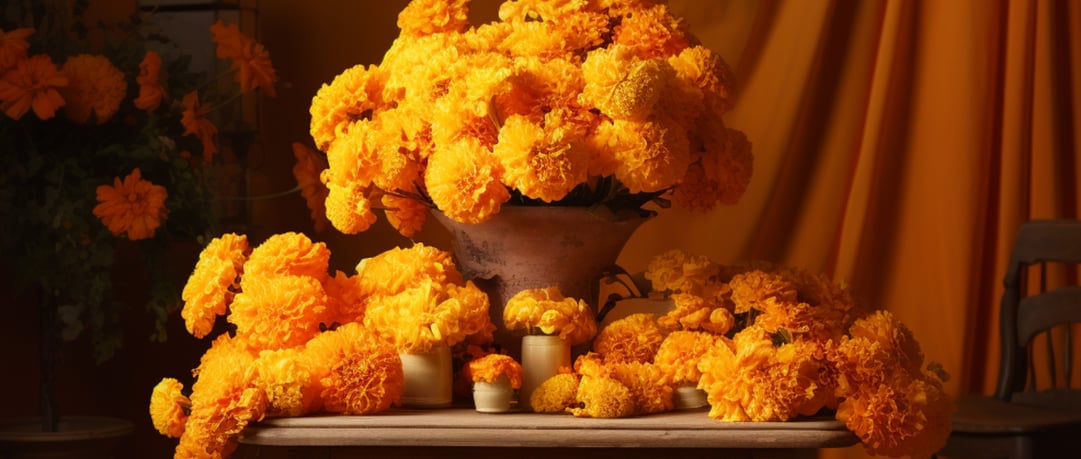Marigolds: The Golden Child of the Flower world


The Marigold: The Golden Flower of the World
Marigolds, often referred to as "the golden flower of the world," hold a special place in many cultures and major holidays such as the Day of the Dead and Diwali. With their vibrant colors, distinct aroma, and versatile uses, marigolds have become a symbol of celebration, remembrance, and beauty. In this article, we will explore how the marigold garnered its esteemed status and why it continues to play a key role in various festivities worldwide.
The History and Significance of the Marigold
Marigolds, scientifically known as Tagetes, have a rich history that traces back thousands of years. Native to the Americas, these flowers were highly valued by indigenous civilizations for their medicinal and spiritual properties. The Aztecs, in particular, held marigolds in high regard, using them in religious ceremonies and as offerings to their deities.
Over time, marigolds made their way to different parts of the world through trade routes established by explorers. As they reached new destinations, their unique characteristics and cultural associations attracted attention and cemented their place in various traditions.
Marigolds in Major Holidays
Day of the Dead
In Mexico, the Day of the Dead, or Día de los Muertos, is a vibrant and meaningful celebration that honors deceased loved ones. Marigolds, commonly known as cempasúchil or flor de muertos, play a vital role during this occasion. Families construct elaborate altars adorned with marigolds, believing that their vibrant colors and fragrant scent guide spirits back to the living world. The petals are scattered on the floor to create a path for the souls to follow.
Diwali
Diwali, also known as the Festival of Lights, is one of the most significant Hindu festivals celebrated around the world. During this festive occasion, marigolds are used to decorate homes, temples, and public spaces. The bright orange and yellow hues of the flowers signify wealth, happiness, and good luck. The presence of marigolds is believed to attract prosperity and ward off negativity.
Other Festivals and Traditions
Marigolds are not limited to just the Day of the Dead and Diwali. These golden blooms hold significance in various cultural celebrations and traditions worldwide. In Thailand, marigolds are commonly used in religious offerings and temple decorations. In India, they are associated with weddings and garlanded around the necks of the couple as a symbol of love and purity. In Nepal, marigolds are an integral part of the Tihar festival, where they are used to decorate homes and welcome prosperity.
The Versatility of Marigolds
Aside from their cultural importance, marigolds also possess practical uses that make them highly versatile. Here are some notable applications of these golden flowers:
Medicinal Properties: Marigolds contain compounds with anti-inflammatory, anti-fungal, and wound-healing properties. Extracts from the flower are used in various forms such as creams, ointments, and essential oils to treat skin conditions, soothe irritation, and promote healing.
Garden Pest Control: Marigolds emit a fragrance that repels certain pests, making them an excellent companion plant. Gardeners often interplant marigolds with vegetables and fruits to deter insects and nematodes, reducing the need for chemical pesticides.
Culinary Uses: While not as widely known as other edible flowers, marigolds are used in some cuisines for their vibrant color and slightly citrus-like flavor. The petals can be used to add a decorative touch to salads, soups, and desserts.
The marigold's journey to becoming the golden flower of the world is a testament to its beauty, cultural significance, and versatility. Whether it's adorning altars during the Day of the Dead or brightening up Diwali celebrations, marigolds continue to bring joy and meaning to people's lives. Their vibrant colors, aromatic scent, and practical uses have truly made them a beloved and cherished flower across the globe. So, the next time you come across a marigold, take a moment to appreciate the history and symbolism behind this seemingly simple flower. You may find yourself captivated by its golden charm and the stories it carries within its petals.
